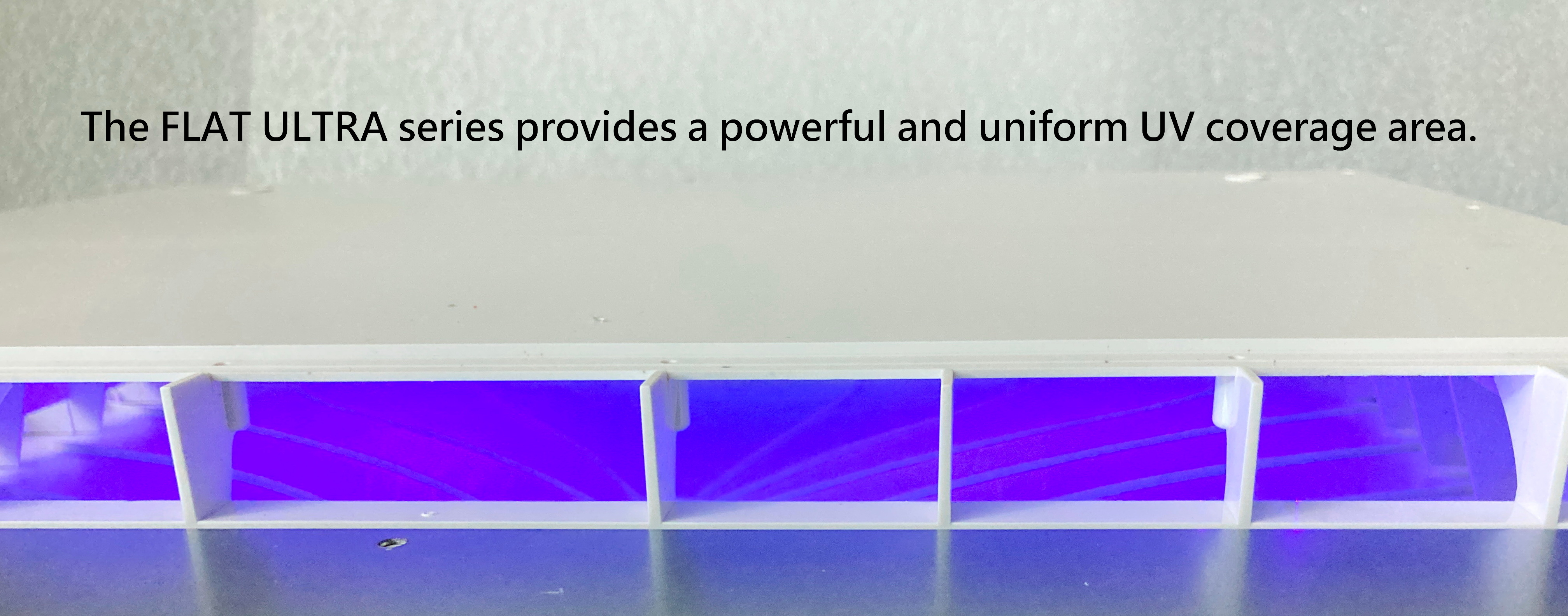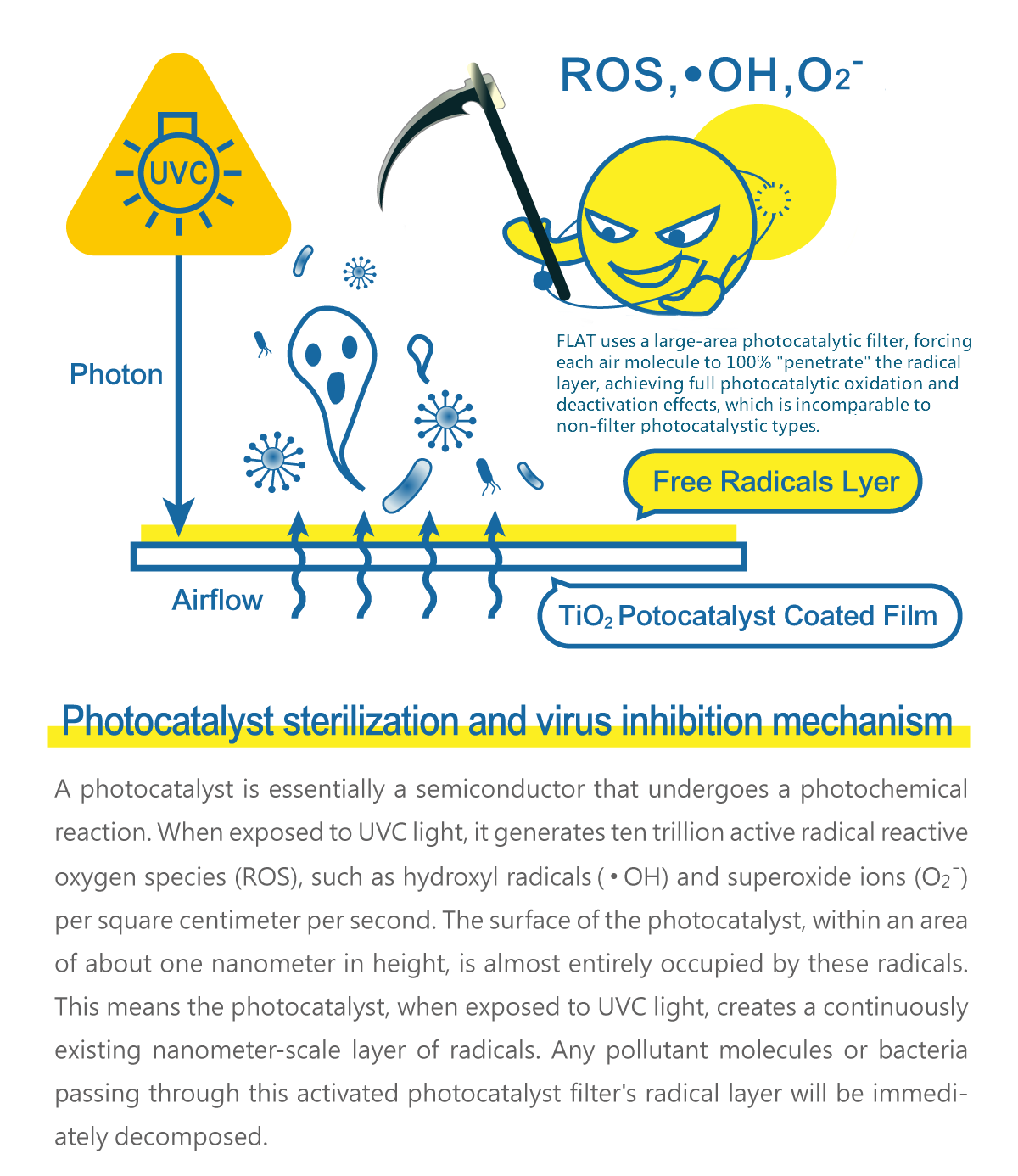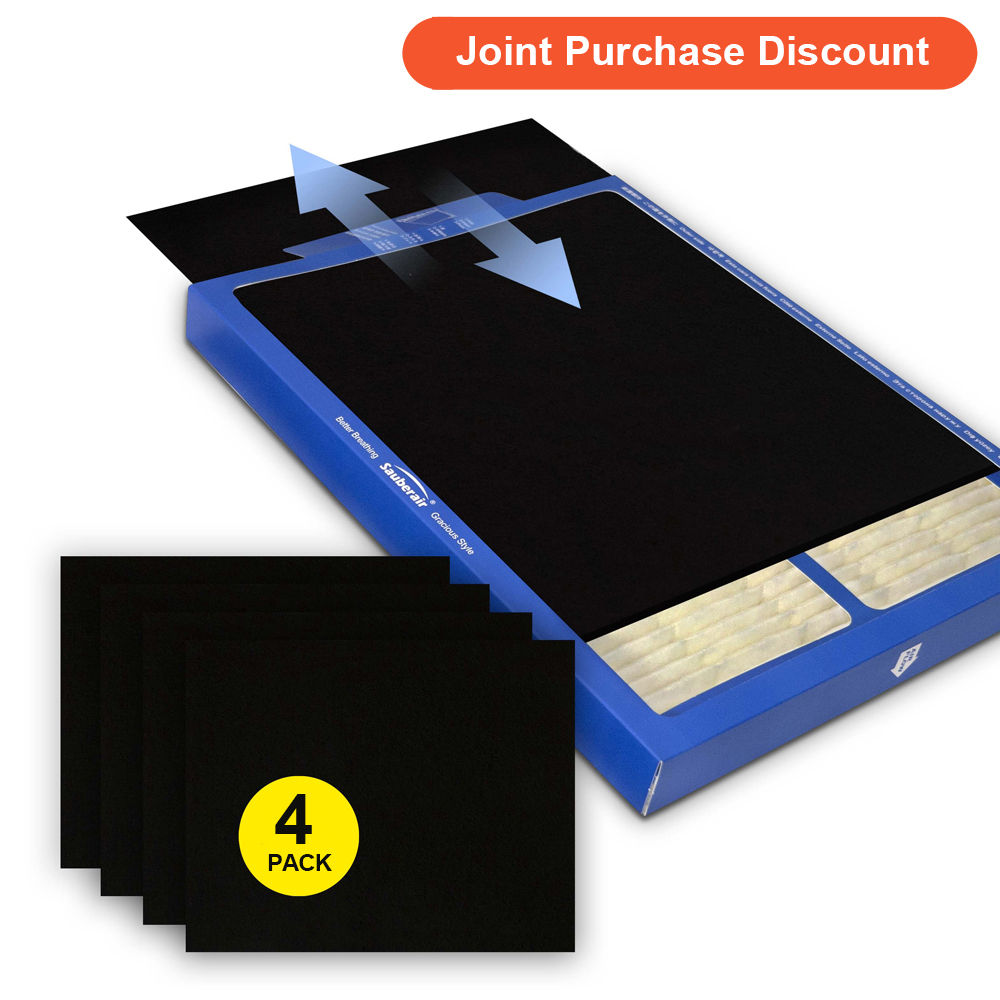UVC and Photocatalyst Effectiveness and Safety
Why did it take us five years to launch a UV sterilization model?
Using UVC light alone, even though UVC with a wavelength of 265 nm is 1600 times more effective at sterilization than 360 nm UVA, the exposure time of the airflow to the UVC light in an air purifier is measured in milliseconds. This duration is too short to achieve sterilization and disinfection. On the other hand, if only UVA is used, it must be irradiated for several hours in still air to kill bacteria. It would merely be a marketing gimmick to deceive consumers!
Why are we now launching a model with a photocatalyst and UVC?
The addition of a photocatalyst filter layer brings a completely different mechanism for sterilizing and inhibiting viruses!
A photocatalyst is essentially a semiconductor that undergoes a photochemical reaction. When exposed to UVC light, it generates reactive oxygen species (ROS), such as hydroxyl radicals (•OH) and superoxide ions (O₂⁻). The ability of the photocatalyst to decompose organic pollutants and kill bacteria and viruses is due to the oxidative-reductive effects of these reactive substances.
After UVC exposure, the surface of the photocatalyst can produce ten trillion active radicals per square centimeter per second. The surface of the photocatalyst, within an area of about one nanometer in height, is almost entirely occupied by these radicals. This means that the photocatalyst, when exposed to UV light, creates a continuously existing nanometer-scale layer of radicals. Any pollutant molecules or bacteria passing through this activated photocatalyst filter's radical layer will be immediately decomposed.
- FLAT-ULTRA is equipped with 32 UVC sterilization LED lights, the most in the world, combined with a photocatalyst filter certified by the Emerging Virus Infection Research Center of Chang Gung University, achieving a 99.99% effectiveness rate in inhibiting the coronavirus in sample tests.
- It uses UVC lights with a wavelength of 275 nm, which are the most effective for sterilization and strongest in activating the photocatalyst reaction. These lights are 1600 times more effective at sterilization than 360 nm UVA, and since the wavelength is not below 240 nm, they do not produce harmful ozone.
- Our FLAT-ULTRA series is equipped with 32 UVC sterilization LED lights with a wavelength of 275 nm, which evenly illuminate the large-area photocatalyst coated film at a distance of 1 cm, strongly activating the large-area photocatalyst reaction. According to SGS tests, the sterilization rate of the total bacteria count in the space (not just a small sample test) is >99.9%.
This is why we are now launching a model with a photocatalyst and UVC—because it is effective.
The FLAT ULTRA series uses up to 32 UVA+UVC dual LEDs, the most in the world, to create a powerful and uniform large-area photocatalytic reaction.


The Germicidal Efficacy of Ultraviolet Light

Short-wave UV LED has other advantages besides sterilization
In addition to the powerful sterilizing effect of UVC, the development of short-wavelength UVC LED has made great progress in the past two years. According to the research results of the paper, to achieve the same sterilization effect, compared with 370nm UVA, the energy consumption of 275nm UVC LED can reach an astonishing 2.7%. Coupled with the simultaneous improvement of high energy efficiency, long life and economic feasibility, now is the time to introduce UVC LED into FLAT applications with sufficient reasons.

Source:
The Wavelength-Based Inactivation Effects of a Light-Emitting Diode Module on Indoor Microorganisms, Int J Environ Res Public Health. 2022 Aug; 19(15): 9659. Published online 2022 Aug 5. doi: 10.3390/ijerph19159659,
https://www.ncbi.nlm.nih.gov/pmc/articles/PMC9368635/
Is there any harm from hydroxyl radicals?
There is no need to worry about inhaling harmful hydroxyl radicals. The radicals generated by the photocatalyst occur because high-energy photons hit semiconductors like titanium dioxide, exciting an electron from a lower to a higher energy level, leaving a hole in the lower energy level. The radicals produced by the photocatalyst have a lifespan of less than a billionth of a second and only exist in the nanometer-scale radical layer on the photocatalyst surface. Due to their high reactivity, once they leave this nanometer-scale layer, they will quickly react with oxygen, water, or other radicals in the air and be neutralized. Thus, there is no chance they will be blown out by the air purifier and inhaled into our lungs.
Source: Professor Hsiao-Chieh Chiang, Department of Chemical and Materials Engineering, National Central University
https://www.lightkiller.com/photocatalyst.htm
Conclusion:
- Any photocatalyst or negative ion device that claims to release hydroxyl radicals into the air to achieve purification is fraudulent!
- If a device cannot provide a full machine sterilization report and only offers small-area test sample sterilization reports, it cannot prove its effectiveness when installed in the machine.
- Our FLAT-ULTRA series, tested by SGS, achieves a whole machine space bacteria sterilization rate of >99.9%.
Is UVC Harmful?
UVC has a short wavelength and the strongest energy, making its sterilization capability 1600 times greater than UVA. It is proven to destroy the chemical bonds in the DNA/RNA of pathogens like bacteria and viruses, preventing them from producing proteins, thus rendering them unable to reproduce or causing their death. However, UVC has poor penetration, with materials like glass and plastic potentially blocking it.
For example, the 275 nm UVC LEDs we use have an adjusted surface irradiation power of 2-3 mW/cm² (similar to the 2-3 mW/cm² intensity of 365 nm UVA under direct sunlight at noon). Because intensity inversely relates to the square of the distance, at 0.5 meters from the LED, the intensity drops about a hundredfold, making it absolutely safe. Since UVC is invisible, our UVC sterilization lights are paired with 396 nm blue-violet visible light, enabling us to see the irradiation area and effectively avoid close-range exposure. Additionally, our FLAT-ULTRA includes a safety power-off device that cuts power immediately if the filter cover is opened, ensuring no chance of exposure to UVC.
How to Convert UV Irradiance (mW/cm²) and UV Energy?
The calculation of light intensity energy is as follows:
0.1 mW/cm² = 1 W/m²
FLAT's adjusted UV irradiance of 2-3 mW/cm² = 20-30 W/m²
Light intensity energy units: J/m², mJ/cm². 1 Joule (J) = 1 Watt (W)/second (S). The energy of FLAT's irradiation per second is 20-30 Joules (J)/m².
According to IEC 62471 standards and recommendations from the International Commission on Non-Ionizing Radiation Protection (ICNIRP), the exposure limit for humans to UV radiation (wavelength 180-400 nm) over 8 hours is 30 J/m². Therefore, we have adjusted FLAT's UV irradiance to ensure it is non-hazardous to humans at 20-30 Joules (J)/m² while maintaining efficient photocatalytic sterilization.
Risk-Free Distance for FLAT UVC
[The intensity of illumination is inversely proportional to the square of the distance]
After adjustment, the irradiance of FLAT UVC at a distance of 1 cm is 2-3 mW/cm² = 20-30 W/m². We will use the highest value of 30 W/m² for calculation. At a distance of 25 cm, the illumination has decreased to 1/25²=1/625. This means the irradiance is 30 W/m²×(1/625)=0.048 W/m², which is far below the IEC 62471 standard limit of 30 J/m².
The risk-free distance we have indicated is even more conservative, at 50 cm. At a distance of 50 cm, the illumination has decreased to 1/50²=1/2500. Therefore, as long as you are at a distance greater than half an arm's length, you do not need to worry about the hazards of exposure to UVC radiation.
Will FLAT's Short-Wave UVC Produce Ozone(O₃)?
UVC wavelengths below 240 nm indeed produce harmful ozone. However, UVC~UVB wavelengths from 240-315nm actually break down ozone molecules bond, converting them back into oxygen (O₂). FLAT-ULTRA uses the safe and highly effective 275 nm UVC, so you need not worry about ozone toxicity.

Source:
- Oxidation Technologies, LLC.
https://www.oxidationtech.com/ozone/ozone-production.html - National Library of Medicine: Ozone Formation during Photocatalytic Oxidation of Nitric Oxides under UV Irradiation with the Use of Commercial TiO₂ Photocatalytic Powders
https://www.ncbi.nlm.nih.gov/pmc/articles/PMC9457229/
| Recommended |

FLAT-LITE Manual Version
Experience the benefit of FLAT in the most economical way!
Smart Package
US$ 599

FLAT™ Wi-Fi / IoT
Perfect blends into your home decor and frees up floor space.
Smart Package
US$ 899








